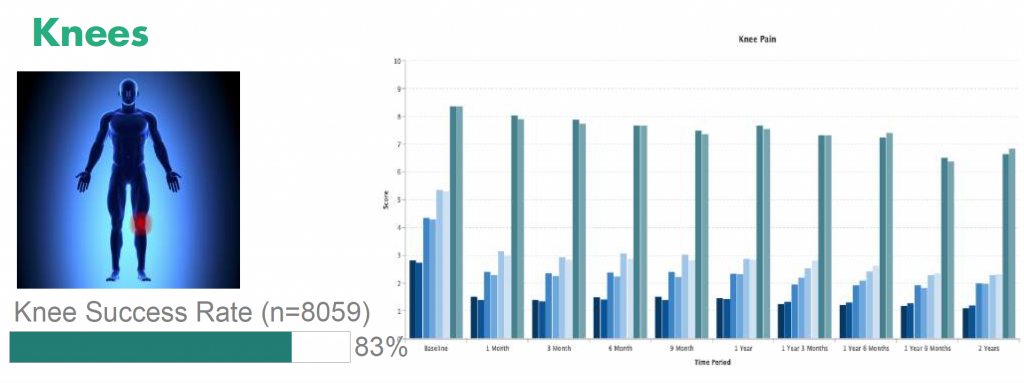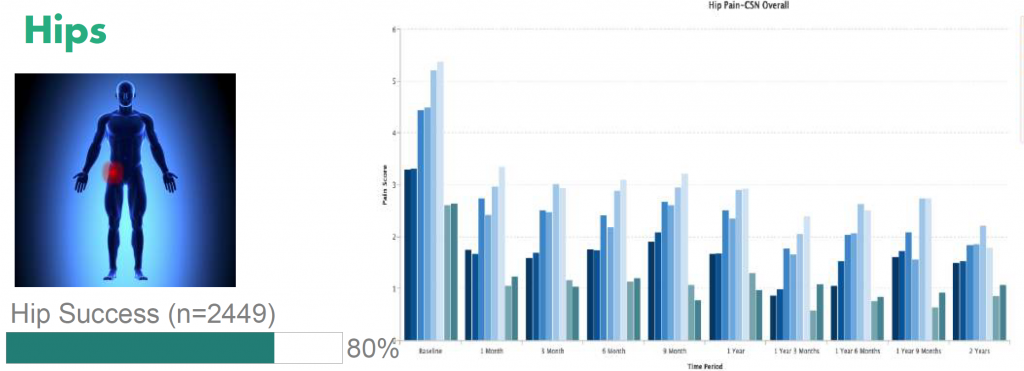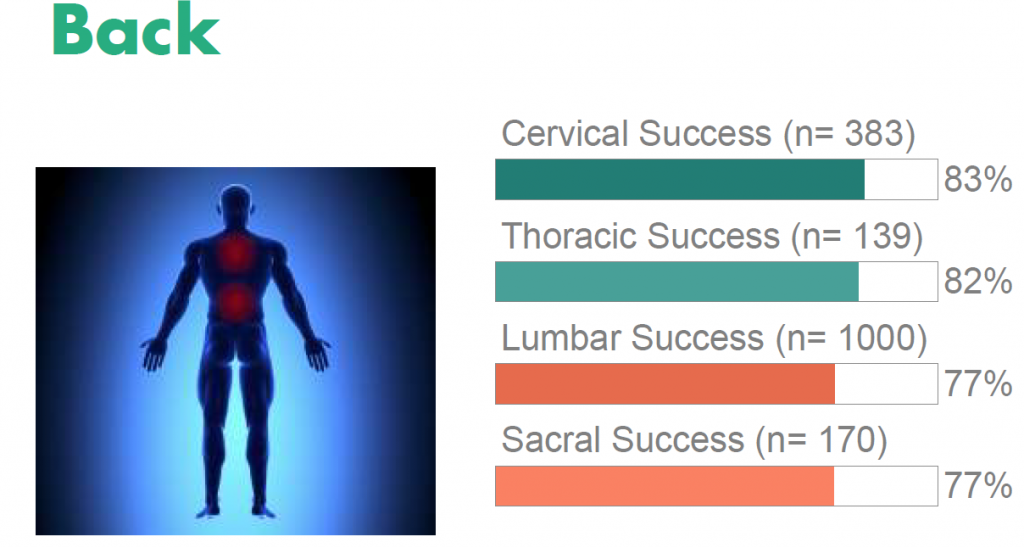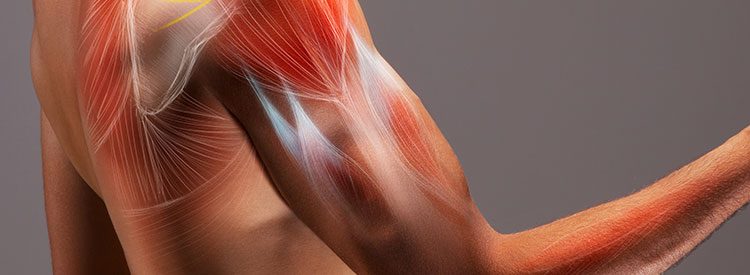Musculoskeletal/Muscles/Joints
According to the American Academy of Orthopaedic Surgeons, fifty percent of Americans suffer from a musculoskeletal injury or disorder. Musculoskeletal injuries and disorders affect the components of the musculoskeletal system, such as the muscles, bones, and joints. Common musculoskeletal injuries and disorders include osteoarthritis, tendonitis, fractures, and muscle/ligament/tendon strains and sprains.
Musculoskeletal injuries and disorders develop because of wear and tear caused by aging, repetitive motion, physical activity or sports, and trauma. Musculoskeletal injuries typically cause inflammation, fatigue, pain, decreased range of motion, and eventually complete loss of function for many individuals.
Tendon/Ligament
Tendon and ligament injuries are the most common kinds of sports-related injuries. Sprains, ruptures, strains, tears, and bruising affect these soft tissues, and they are also prone to developing injury from overuse. Inflammation is also a problem for tendons and ligaments. Patients with tendon and ligament injuries that occur because of sports often experience pain and are often unable to use the affected area, which can limit activity and may even limit mobility. Tendon and ligament injuries require long periods of rest and inactivity and may require rehabilitation, steroids, or surgery. See our blog: Nagging Injuries
For tendon and ligament injuries, Innovations Stem Center deploys SVF stem cells by injection to target affected tissue in combination with intravenous deployment to enhance outcomes and reduce inflammation.
Most of our patients with tendon injuries see improvement in just 1 to 2 days. These improvements include reduced pain and increased range of motion and mobility. Patients gradually continue to improve while stem cells help to heal damaged tissue. Fractures may heal faster and hurt less. Some sports injuries require a second deployment, 3 to 6 months after treatment, to further improvements or regain benefits lost since initial treatment.
Knee
Arthritis can impact any joint in the body, but it is very common in the knee. Knee joints get a lot of use from walking, running, and other types of activities. Knee arthritis makes many of these activities painful and difficult, if not impossible, for many patients. Arthritis of the knee develops when the cartilage of the knee joint wears away over time from use or becomes damaged because of injury. The most common symptoms of arthritis in the knee include pain, swelling, stiffness, and difficulty bending or straightening the leg. Some patients experience creaking or popping noises when bending the knee. For many patients with knee arthritis, symptoms are more severe after periods of rest. Knee joint arthritis patients often face knee replacement surgery, which means long periods of downtime and painful recovery.
In many cases, Innovations Stem Cell Center helps patients avoid painful knee replacement surgery and a lengthy recovery by treating joint pain with the patient’s own stem cells. Stem cells are deployed by injection to the knee, and in many knee joint arthritis cases, stem cells are also deployed IV to help reduce inflammation in the joint.
Results From the First 8000 Knees Treated by the Cell Surgical Network

Patients who undergo SVF stem cell therapy for knee joint arthritis report a reduction in their painful symptoms and an increase in range of motion and mobility. Stem cell therapy helps to quickly reduce knee joint inflammation, and many patients see improvements in just 1 to 2 days. Anti-inflammatory results of the procedure last 2 to 3 months and many patients see a gradual improvement in their overall condition over time.
Hip
Just like the knee, the hip joint is susceptible to developing arthritis. Causes of arthritis in the hip include age, activity, being overweight, and injury. Over 25 percent of adults over the age of 55 will develop arthritis pain in their hip. This pain severely limits mobility in many people and makes walking, climbing stairs, and other everyday activities painful, difficult, and in severe cases, impossible. Patients with hip joint arthritis experience pain in the hip, knee, thigh, or buttocks. Hip joint arthritis pain may be sharp or dull. Many patients also report stiffness in the joint after periods of rest. In most cases of hip joint arthritis, patients face having to avoid their favorite activities and must resort to surgery to find relief.
In many cases, Innovations Stem Cell Center helps patients avoid painful hip replacement surgery and a lengthy recovery by treating hip joint pain with the patient’s own stem cells. Stem cells are deployed by injection into the hip, and in many hip joint arthritis cases, stem cells are also deployed IV to help reduce inflammation in the joint.
Results From the First 2500 Hips Treated by the Cell Surgical Network

Patients who undergo SVF stem cell therapy for hip joint arthritis report a reduction in their painful symptoms and an increase in range of motion and mobility. Stem cell therapy helps to quickly reduce hip joint inflammation, and many patients see improvements in just 1 to 2 days. Anti-inflammatory results of the procedure last 2 to 3 months and many patients see a gradual improvement in their overall condition over time.
Shoulder
Arthritis can also develop in the shoulder joint, too. Inflammation occurs because of wear and tear, which happens from overuse or as a natural part of aging. Shoulder arthritis can also develop because of an injury or trauma, or because of tears in the rotator cuff, the muscles that keep your arm in your shoulder socket and allow you to lift your arm. Signs of shoulder arthritis include pain, typically aggravated by activity and gets worse over time. Pain may spread throughout the shoulder and to the neck, depending on the location of inflamed tissue in the shoulder joint. Many shoulder arthritis sufferers complain of limited motion and the inability to lift their arms. Some patients report clicking and popping noises with motion, and a grinding feeling with movement. Traditional treatments for surgery include long periods of rest, pain relievers, and in many cases, surgery.
In many cases, Innovations Stem Cell Center helps patients avoid painful shoulder surgery and a lengthy recovery by treating shoulder arthritis pain with the patient’s own stem cells. Stem cells are deployed by injection into the shoulder, and in many shoulder joint arthritis cases, stem cells are also deployed IV to help reduce inflammation in the joint.
Results From the First 3000 Shoulders Treated by the Cell Surgical Network

Patients who receive stem cell therapy for shoulder arthritis report a reduction in their painful symptoms and increased range of motion and mobility. Stem cell therapy helps to quickly reduce joint inflammation, and many patients see improvements in 1 to 2 days. Anti-inflammatory results of the procedure last 2 to 3 months and many patients see a gradual improvement in their condition over time.
Neck and Back
Neck or back injuries and pain are among the most common complaints seen in the doctor’s office. Low back pain is the single most common cause of missing a day at work in the United States. For many, a few days of rest can give good results. However, those with chronic back pain can suffer for years. Treatment consists of physical therapy and exercise, anti-inflammatory drugs, pain medications and sometimes surgery. While neck or back surgery for pain in the arms or legs is often very effective, neck or back surgery for neck or back pain is often unsuccessful. In fact, many patients end up with little or no relief after neck or back surgery.
Stem cells from your own fat at Innovations Medical can help relieve neck or back pain in many individuals. Stem cells are delivered both IV and in the area of pain. A specialist is required to perform neck and back injections, so there is an additional charge for these areas. Results are encouraging, especially when you consider that most of these patients have tried and failed with many other treatments including surgery.
Results From the First 1700 Backs Treated by the Cell Surgical Network
 Patients see an improvement in pain and mobility. Results can occur as soon as 1-2 days. However, many patients see a gradual improvement beginning in a few weeks and improving for a year or more. Most patients do well with a single treatment. Occasionally, some patients will have a repeat treatment to see if further improvement is achievable.
Patients see an improvement in pain and mobility. Results can occur as soon as 1-2 days. However, many patients see a gradual improvement beginning in a few weeks and improving for a year or more. Most patients do well with a single treatment. Occasionally, some patients will have a repeat treatment to see if further improvement is achievable.
Cost of Stem Cell Treatment
The cost of the initial treatment ranges from $5,000 to $10,000. The range in cost is dependent on the complexity of delivering the cells back to you. For example, spine conditions require multiple physicians to deliver the cells back to your body and this requires an increase in cost as multiple doctors are involved in the procedure. For many people the initial treatment is all that is needed; however, for some conditions, subsequent treatments may be required and these are done at a reduced fee. Innovations Medical provides Stem Cell Therapy procedures at both our Dallas and Fort Worth practice locations.
To learn more about stem cells see our blogs What are Stem Cells? and Understanding Adipose-Derived Stem Cells

